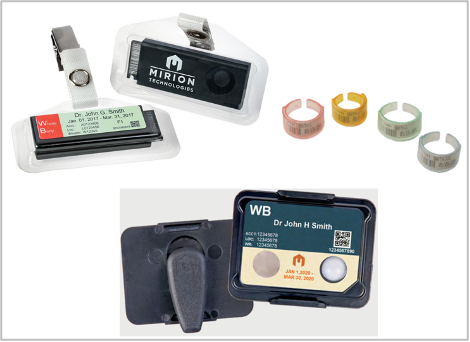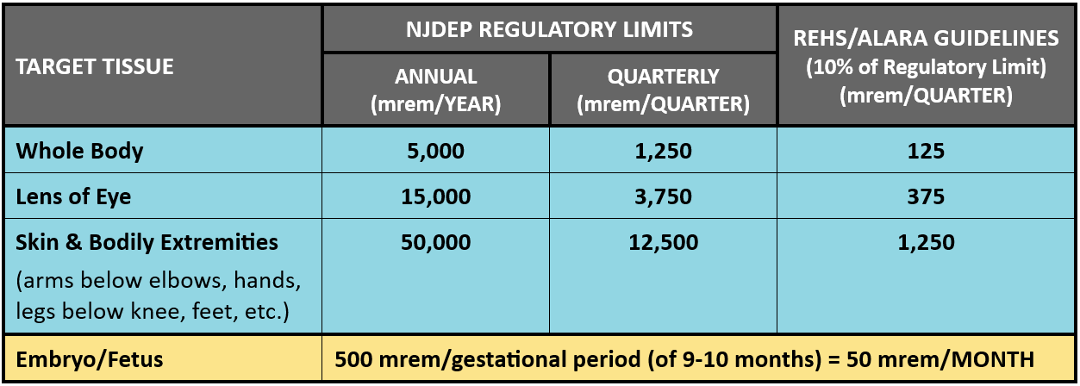- What is Radiation Dosimetry?
-
Radiation dosimetry is the measurement of external ionizing radiation absorbed by the body. Dosimeters (aka radiation badges), such as a ring or whole body badge, are passive radiation detectors that record the radiation dose received. The type of dosimeter to use depends upon factors such as the type and amount of radiation, purpose/task, and proximity to radiation. Personal dosimeters are worn on the worker’s body, whereas area monitoring dosimeters (when applicable) are placed in or just outside of a room that houses an x-ray producing machine, irradiator, or certain radioactive materials.

REHS provides dosimetry to employees who work with radiation sources that emit a certain level of ionizing radiation. According to the regulations outlined by the Nuclear Regulatory Commission (NRC) and/or the New Jersey Department of Environmental Protection, Rutgers University and RWJMS are not required to provide dosimetry (radiation monitoring badges) to the vast majority of researchers working with radioactive materials (RAM). However, Rutgers does provide dosimetry to a select worker population at each campus that works with high-energy beta emitters, select gamma emitters, and some radiation producing machine sources.
- How to Wear and Use a Dosimeter
-
Whole Body Badges
- Whole body badges measure deep and shallow doses.
- Wear the badge on the torso between the neck and waist in a spot that is closest to the radiation source, with the front label of the badge facing the radiation source.
Ring Dosimeters
- Ring dosimeters measure doses to an extremity (e.g., hand).
- Wear the ring on a finger of the hand that is closest to the radiation source most of the time.
- Ensure the label of the ring is facing the radiation source (typically facing the palm of the hand).
- When gloves are worn, wear the ring underneath the gloves.
Information on the dosimeter label includes the wearer name, wearer number, wear period dates, account number, location number, and type of dosimeter.
The dosimeter(s) issued to you is designed to monitor your occupational radiation exposure. Please ensure you understand the rules and limitations of these dosimeters. Notify REHS if there is a change of radiation sources that you will be working with so that REHS can determine if dosimetry changes are warranted.
- Dosimeter Exchange and Processing
-
In order to process the used dosimeters, REHS will exchange the worker’s dosimeter(s) from the previous wear period with a new batch for the next wear period at these designated intervals:
- Quarterly (every 3 months): at the beginning of January, April, July, and October for most workers
- Monthly: in the first week of every month for fetal badges
Ensure your dosimeter(s) from the previous wear period is available for exchange during these times. When you receive your new dosimeter(s), either by REHS delivery or campus mail, please promptly return any dosimeter(s) from the previous wear period to REHS. Your dosimeter(s) cannot be submitted for processing if they are not exchanged on time.
The dosimeters from the previous wear period are mailed to the university’s dosimetry vendor where the captured doses can be processed for that wear period to generate a radiation exposure report for each worker. The type of dosimeters that are used at the university does not provide immediate feedback for real-time doses.
Notify REHS if you are no longer working with radiation sources or are departing the university so that REHS can cancel your dosimeter(s).
- Radiation Dosimeter Rules
-
- Wear dosimeters properly. Ensure the dosimeter is worn on the appropriate part of the body and with the front label facing the radiation source.
- Do not share your dosimeter with another person. Your dosimeters are assigned to only you. Any doses received by the dosimeter will be recorded under your name and kept as a permanent record. If someone in your lab needs a dosimeter, please contact REHS so a spare dosimeter can be issued to them.
- Do not deliberately expose dosimeters to radiation and/or heat. If you think your dosimeter(s) was exposed to radiation or heat inadvertently, contact REHS for instructions. Unintended radiation or heat can yield inaccurately elevated radiation doses. Unintended heat also has the potential to erase any recorded exposures. Do not leave your dosimeter in or next to any radiation sources, on a window sill, inside a hot car, or at other places that are hot or exposed to the sun.
- Do not wear your dosimeter during personal medical tests (e.g., medical x-rays, dentistry appointments, nuclear medicine procedures, etc.), as these are not occupational radiation doses.
- Return dosimeters on time. Ensure your dosimeter(s) is available for exchange during REHS’ designated exchange periods. When you receive your new dosimeter(s), either by REHS delivery or campus mail, promptly return any dosimeter(s) from the previous wear period to REHS. Your dosimeter(s) cannot be submitted for processing if they are not exchanged on time. A non-returned/late fee may be issued for dosimeters that are not returned to REHS within 90 days after the end of the wear period.
- Notify REHS if your dosimeter is lost or damaged. REHS can quickly issue a replacement dosimeter.
- Store your dosimeter at a safe distance from a radiation source where radiation levels are below background, and either in the lab or a designated area when not in use.
- Notify REHS when you no longer require a dosimeter or depart the university.
- Wear dosimeters properly. Ensure the dosimeter is worn on the appropriate part of the body and with the front label facing the radiation source.
- Radiation Dosimeter Limitations
-
- Dosimeters are passive devices that record the amount of external radiation that you are exposed to. At certain intervals (monthly or quarterly), the used dosimeters are mailed to the dosimetry vendor for processing. Several weeks later, the results of your dosimeter exposures are then reported to REHS. Dosimeters do not provide any active protection against radiation in real time, and they do not absorb radiation. Your radiation dosimeter is purely to monitor the amount of radiation you may have been exposed to during your occupational work so that you do not exceed the regulatory limits set forth by the NJDEP.
- Dosimeters have a minimum detectable level for radiation; therefore, a dose less than these levels will not be recorded or reported.
- Minimum detectable level for a whole body badge = 10 mrem
- Minimum detectable level for a ring dosimeter = 20 mrem
A badge report with “ND” (“nondetectable”) listed as the reportable dose means that the dose received was less than the minimum detectable level of the dosimeter.
Your dosimeter will not record doses from certain radioisotopes that have lower beta energies, such as H 3, C 14, or S 35, which emit radiation that is too low for the dosimeter to record. The dosimeters used at the university work best with higher energy beta emitters (e.g., P-32, etc.), gamma emitters (e.g., Cr-51, I-125, etc.), and x-rays.
- Dosimeters will record any external radiation exposure above their minimum detectable level.
Radiation sources that a dosimeter can detect above its minimum detectable level within a certain unshielded distance are:- Radiation-producing machines that emit ionizing radiation beyond the unit itself (typically, those used for medical use)
- Certain radioactive materials (excluding certain radioisotopes that have lower beta energies)
- NOTE: if your dosimeter(s) is stored near any radiation-emitting source, it will record a dose that is not reflective of your occupational exposure.
NOTEWORTHY INFORMATION:
- When the ALARA principles are followed, the radiation dose recorded by the dosimeter is usually low or below the minimum detectable limit.
- Most analytical radiation-producing machines (e.g., electron microscopes, etc.) used at Rutgers contain the radiation within the unit itself which eliminates radiation emission to bystanders when the machine is used as intended.
- Radioactive materials that are used in a university setting, such as Rutgers, are usually in small quantities/activities. Therefore, the radiation dose recorded by the dosimeter is usually low or below the minimum detectable limit
- Dosimeters used at Rutgers will not record radioactive material taken into the body. If a small quantity/activity of radioactive material accidentally enters the body (i.e., by inhalation, ingestion, injection, or skin absorption), these internal doses will not be recorded by the dosimeter. If you suspect that you received an internal radiation dose, regardless of the quantity or activity, contact REHS immediately.
Internal exposures can be avoided by carefully planned and executed experimental procedures, including the use of proper personal protective equipment (e.g., lab coat, gloves, safety glasses/goggles, etc.). To identify potential areas of contamination, which, therefore, helps you avoid potential internal exposure, surveys that are appropriate for the type/energy of the radioisotope can be performed (i.e., using a handheld survey meter and/or conducting wipe testing).
- If you have had a medical test that involved the use of a radionuclide (e.g., nuclear medicine scan, stress test, etc.), you should not wear your dosimeter(s) at work during the radionuclide decay timeframe. The radioactive material used for these medical procedures/tests usually involves gamma-emitting radionuclides, which would cause your dosimeter(s) to record a falsely elevated dose. These personal medical procedures/tests are not occupational exposures to radiation. If you have had one of these procedures/tests, please contact REHS for consultation.
- Dosimeters are passive devices that record the amount of external radiation that you are exposed to. At certain intervals (monthly or quarterly), the used dosimeters are mailed to the dosimetry vendor for processing. Several weeks later, the results of your dosimeter exposures are then reported to REHS. Dosimeters do not provide any active protection against radiation in real time, and they do not absorb radiation. Your radiation dosimeter is purely to monitor the amount of radiation you may have been exposed to during your occupational work so that you do not exceed the regulatory limits set forth by the NJDEP.
- Radiation Exposure Limits and Records
-
Annual radiation exposure records (called “Form 5”) are mailed in March to individuals who received a detectable dose above 100 mrem over the course of the previous year. If you do not receive a Form 5, then your radiation exposure doses are non-detectable (ND). You may request a copy of your dose report anytime throughout the year.
The radiation exposure limits are defined in the table below.

Our goal is to keep your dose ALARA (as low as reasonably achievable). By following these rules and understanding the limitations of your dosimeter, unnecessary radiation doses can be avoided.
If you no longer need a dosimeter or your work with radiation sources has changed (i.e., you no longer work in a lab with radioactive materials or radiation-producing machines, your radioactive material work has changed, you are departing Rutgers, etc.), please contact Dosimetry Program Management (see contact info below) and send a note along with your dosimeter(s) by campus mail to:
REHS-Radiation Safety, 74 Street 1603, Building 4116, Livingston Campus, Rutgers University
Thank you for your cooperation with the Rutgers dosimetry program!
Contact
Dosimetry Program Management:
Leo Trooskin & Diana Smith
radgroup@ipo.rutgers.edu
(848) 445–2550
Health Safety Specialists (By Campus Assignment) or call (848) 445-2550

